How to make and install a forged gate yourself
Forged gates, as well as gates or fences, can be called one of the most attractive designs when compared with other analogues. The price of the finished product, which is created by artistic (hot) forging, is very high. For this reason, such designs are usually not chosen for budget fences, but you can try to make a gate yourself using simpler technologies.
Advantages and disadvantages of forged products
The most significant advantage is the aesthetic appeal. Forged gate will decorate the site. This option goes well with other types of materials: wood, corrugated board, polycarbonate, brick, stone. Accordingly, if a fence such as a picket fence or a stone structure is being erected on the site, it is quite possible to install a gate and gates made by cold forging.
Other positive qualities:
- Resistance to solar radiation (does not change properties, does not fade);
- Increased degree of strength;
- Very long service life (tens of years);
- Uniqueness is inherent in products created using hot forging technology, but even if the gate is made by cold forging, you can take the original pattern as a basis, and you will get an equally interesting design.
When such products are planned to be installed on your site, you need to take into account their shortcomings: a labor-intensive manufacturing process, a high price. And in addition to that, such structures are characterized by a large weight, which will require laying a reliable foundation.
Manufacturing
Regardless of whether it is planned to make a gate or a gate, the sequence of actions will be similar. Only for different designs a frame of certain dimensions is being prepared. The pattern can be repeated on any product.
Let's watch the video tutorial:The whole manufacturing process
Material marking, sketching
For work, you will need a grinder (for cutting metal, grinding), a welding machine. Cold forging technology is implemented using a specific tool. First of all, you need a twisting machine. It can be a "snail", a gnutik, a twister, a template.
Elements of artistic forging
Additionally, a vice is also used, with their help, the parts are adjusted to the desired shape and size. Small tools will also be used in the work: a hammer, pliers, a file.
You can make all the details yourself, but it is possible to purchase ready-made elements for a future design. At the first stage, a sketch of the product is drawn up. The dimensions of the frame are determined, and then it is filled with forged parts, taking into account your own preferences and capabilities. The gate and homemade forged gate must match each other in height, as well as in terms of frame parameters: the same material with an equal cross section (a 30x30 mm pipe is enough).
Large forged parts are made from a metal bar 12-14 mm. For small elements, smaller rods are sufficient - a square of 10 mm. Having marked the pipes for the frame in accordance with the sketch, you should proceed to cutting. This must be done by constantly turning the pipe. This will provide a more even cut.
Forging and welding process
Products created by cold forging are produced starting from the frame. After cutting the metal according to the sketch, you can proceed to welding. First, all pipe sections are laid on a flat surface, then using a tape measure, you need to check whether the design corresponds to the sketch and the given dimensions.
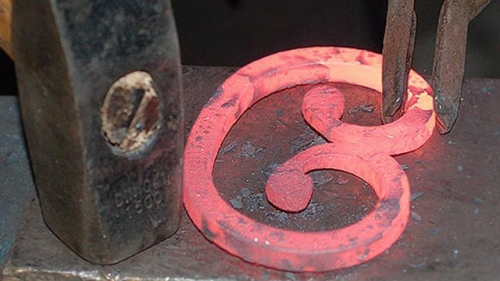
Hot forging: uses most of the technologies of the metal processing itself, this has a better effect on the variety of decor options.
Welding is performed by tack welding (from above, from the side). Such a measure will avoid serious mistakes. If no inaccuracies are found during the re-measurement, it is possible to weld the products with a full-fledged welding seam.
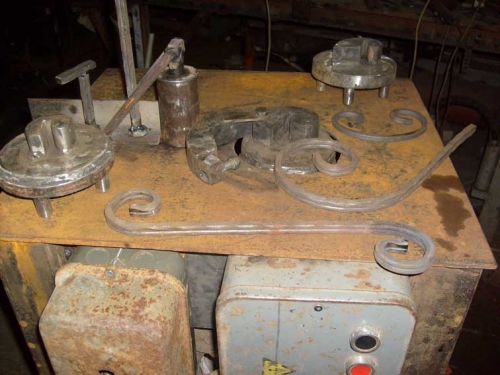
Cold forging is the shaping of metal by bending, pressing and welding. This method is easier to perform.
To find out the actual length of the blanks for making curls, you should print or copy with chalk on the floor the finished sketch in full size. Then it remains to measure the curls using a centimeter. In accordance with these measurements, metal rods are cut.
When starting the forging stage, it is important not to twist the blanks, as in this case it will be more difficult to obtain symmetrical elements.
Video lesson 2: Figured forging elements
If the material is slightly warmed up, this will simplify the task of making forged parts. But in this case, you can not lower the metal into water for the purpose of cooling. This will lead to the fact that the workpieces will be hardened and it will be impossible to work with them further (to bend, change shape), since the bar will break.
When all the elements for the future product are prepared, they must be placed on a flat horizontal surface, preferably right inside the frame. Further, it remains only to grab all the elements with a welding machine. The length of the weld must not exceed 1 cm for curved elements. The joints are polished with a grinder.
Decorative elements (leaves, flowers, etc.) made of thin metal must be welded at low current using the tack method. Otherwise, the details can be burned through.
Installation
If at the design stage and laying the fence posts, there were no racks on which the gate and the gate will be hung in the future, you can install them later. But in this case, you will have to use a columnar foundation.
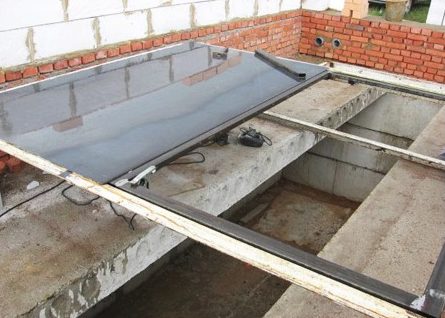
We make the frame: All elements should be pressed with clamps, this will exclude a change in the design when the metal is heated.
The fact is that a monolithic base (tape-columnar) implies the need to fill the entire strip with a solution at once. Staged concreting of the strip base helps to reduce its reliability.
If the entire fence is located on a continuous strip of the foundation, separate pillars can be provided for the gate and the gate. The lower part of the metal supports is coated with a protective compound to avoid rust formation.
Installation of supports
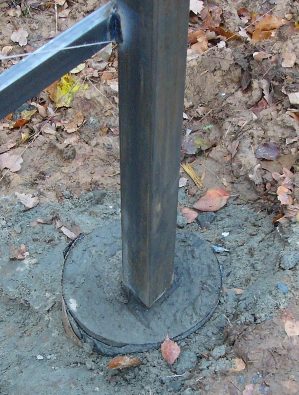
It is better to fill the foundation for the supports with concrete completely
Their laying is carried out to the same depth as the entire fence. But if the fence is made of lightweight material, it is recommended to prepare a reliable base for the gate and the gate - with a deeper location of the support posts. At the same time, a drainage cushion (sand, crushed stone) is prepared at the bottom of the holes.
But this is too time-consuming process, so metal racks are more often used: round with a diameter of 100 mm or square - 100 mm on the side.
Hanging a gate
The number of loops depends on the weight of the product. For lighter structures, 2 pieces are enough; heavy and large-sized gates are hung on three hinges. The fastening of these elements to the metal frame is carried out at the stage of its manufacture.
It should be noted that the lower loop should be located at a level of 40 cm from the bottom point of the frame. And when the gate or gate is hung on supports, there should be a gap of 8-10 cm between the ground surface and the frame.
Painting
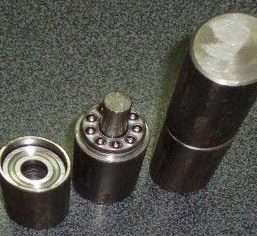
Choose powerful canopies with bearings
It is recommended to open the gate with paints and varnishes after it has been made. To do this, the entire structure is cleaned with a hard metal brush, and dirt is also removed. Then you need to cover the product with a primer. After it has completely dried, the structure is painted.
A common option is black matte finish. For decoration, forged gates, as well as gates, are covered with golden or silver paint. It is necessary to do this only on some details.
To get the effect of antiquity, patina is used. At this stage it is recommended to use a stiffer brush and the material should be applied in a semi-dry state.
Let's watch the video review:The final stage, painting and fitting
Question price: buy or make?
The difference in cost will be significant. On average, the production price of 1 sq. m of forged construction is 3,000 rubles. Moreover, the installation of the product should be taken into account (2,5000 rubles / sq. M). The cost of a homemade gate is lower: about 2,000 rubles / sq. m. And the installation can be done by hand, which will save money.
A forged gate will cost less, in which all the decorative elements were made independently. If you buy them in a store, the design will cost more. Finished forged inserts (250x2500 mm) are offered at a price of 1,200-1,700 rubles.
Another feature is that artistic forging usually allows you to create a unique product, while decorative elements made by cold forging are patterned and can also be used in other fences. That is why there is sometimes a very significant difference in the cost of these design options.
